Yu Chengdong Issues Bold Challenges Amidst Intensifying Intelligent Driving Race
![]() 02/28 2025
02/28 2025
![]() 653
653
The battle for supremacy in intelligent driving is set to ignite, with the stakes rising ever higher.
On February 20, at the Zenith Technology Conference, Yu Chengdong, Executive Director of Huawei Group, Chairman of the Terminal BG, and Chairman of the Intelligent Vehicle Solutions BU, dedicated 90 minutes to elucidating why "Zenith S800 is worth at least 1 million yuan."
The answer lies in its cutting-edge technology.
During his presentation, Yu Chengdong refrained from disclosing any new information regarding Huawei's L3 architecture, briefly mentioning in the PPT that "Huawei's ADS intelligent driving will be L3 Ready by 2025." He emphasized that the commercialization of L3 autonomous driving is a top priority for HarmonyOS Intelligent Driving in 2025.
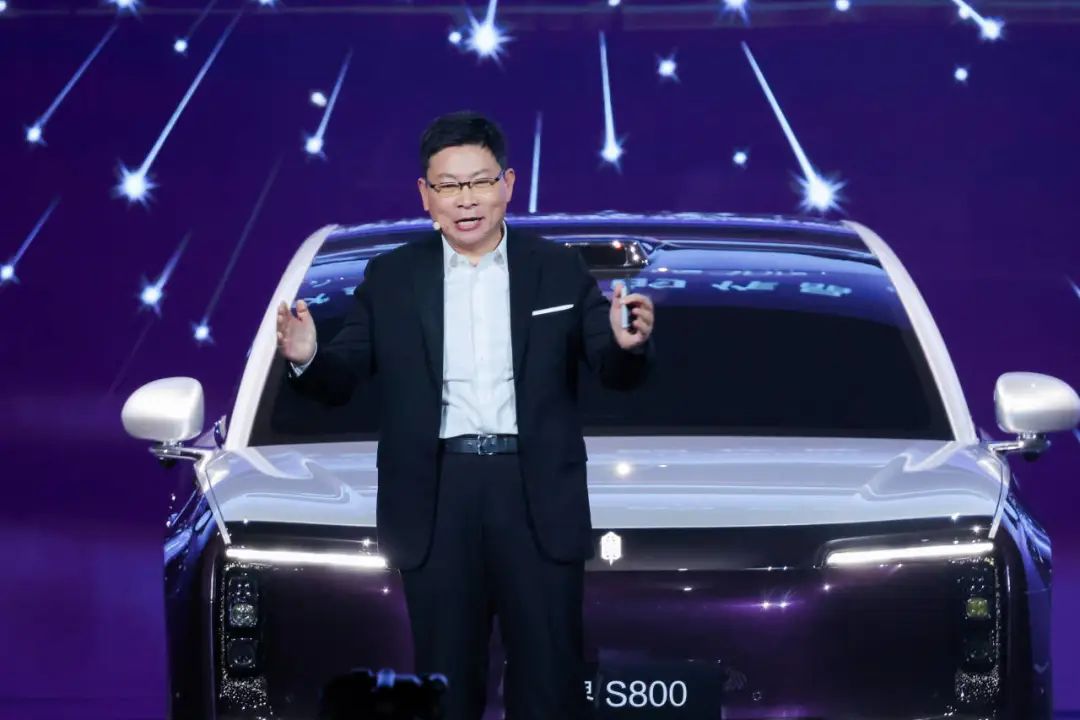
As everyone knows, this year will witness a fierce competition among automakers in intelligent driving, described as a high-stakes race for computing power, data, and ambition.
Just as Yu Chengdong introduced Zenith S800's advanced technology, anticipation was high for Xiaomi to disrupt the scene with its SU7 Ultra. However, Tesla struck first with a surprise move.
On February 25, Tesla officially began rolling out its FSD intelligent driving feature in batches to the Chinese market. Though the current version is not fully functional, its evolutionary capabilities cannot be underestimated.
With the entry of FSD into China, the intelligent driving race has officially entered a real-world, "guns blazing" stage.
Yu Chengdong and Li Bin's "Debate on Mount Hua"
Yu Chengdong has always been confident in Huawei's intelligent driving technology. The market's affirmation of Huawei's intelligent driving technology is also the source of Yu Chengdong's confidence in Zenith S800.
Yu Chengdong revealed that the market's enthusiasm for Zenith S800 is high. Despite its price tag of over 1 million yuan, 2,108 orders were placed within 48 hours, giving Yu Chengdong great confidence. Since its launch at the end of last year, Zenith, with its luxury positioning, has garnered significant attention.
At the time, the industry questioned, "What does Huawei have to support Zenith's million-yuan price tag?" At the conference, Yu Chengdong discussed six new technologies.
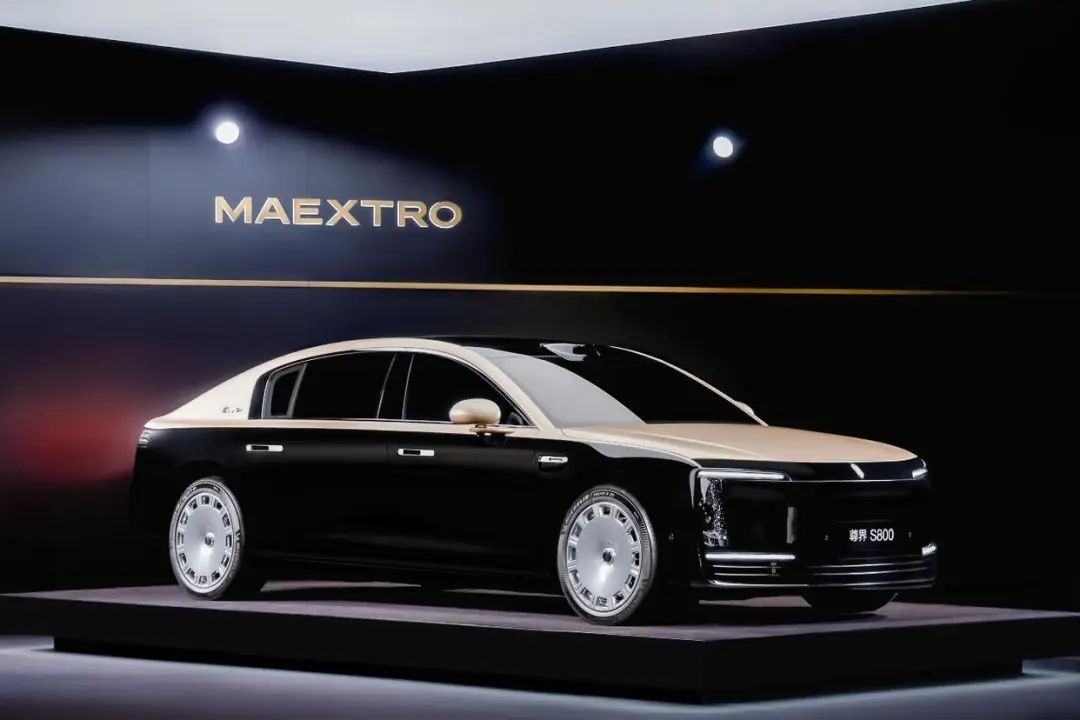
Among them, three are first-time releases: the Tunling Dragon Platform, the Active Safety Protection System, and the In-Vehicle Communication System. The other three are upgraded technologies: HarmonyOS ALPS Cabin 2.0, Huawei Vehicle Language System 2.0, and Huawei Giant Whale Battery 2.0, leading the evolution of smart cars from passive intelligence to autonomous intelligence.
"From passive intelligence to autonomous intelligence, cars have finally ushered in their moment of awakening." This is the slogan of the conference and Huawei's ambition in the intelligent driving race.
One of the most eye-catching features is the chassis. Zenith S800 utilizes Huawei's latest digital chassis technology: the Tunling Dragon Platform. This chassis platform employs distributed electric drive, brake-by-wire, multi-wheel steering, and active suspension technologies.
"Huawei's Tunling Dragon Platform adopts a domain-integrated architecture, evolving decision-making control from reactive to proactive through active perception, central control, intelligent reasoning, and autonomous learning," said Yu Chengdong.
This groundbreaking domain-integrated architecture enables active perception, central control, intelligent reasoning, and autonomous learning, achieving comprehensive intelligent coordinated control. Even in complex road conditions, it maintains the vehicle's excellent stability and comfortable driving experience.
At the conference, Yu Chengdong demonstrated Zenith S800's ability to maintain control when a front tire blows out at speeds of 120 km/h and when taking a turn at 80 km/h. However, before the demonstration, Yu Chengdong issued a polite challenge regarding the tire blowout test.
He first praised NIO's ET9 for its rear tire blowout test, which maintained stability even at speeds of 160 km/h. He then said, "Li Bin showed a rear tire blowout, but today Huawei will present a more challenging front tire blowout test. Everyone knows that front tire blowouts can easily lead to loss of control, making our test more difficult than a rear tire blowout." The operating logic of Zenith S800 and NIO ET9 is similar, both following the "perception-decision-execution" model.
In response, Li Bin, the founder of NIO, commented, "My colleagues showed me the video of Zenith S800 maintaining control during a front tire blowout in the afternoon. It's very impressive." He also said, "It would be best if the CEO personally conducted the tire blowout test. Yu, how about we, fellow Anhui natives, make a plan?"
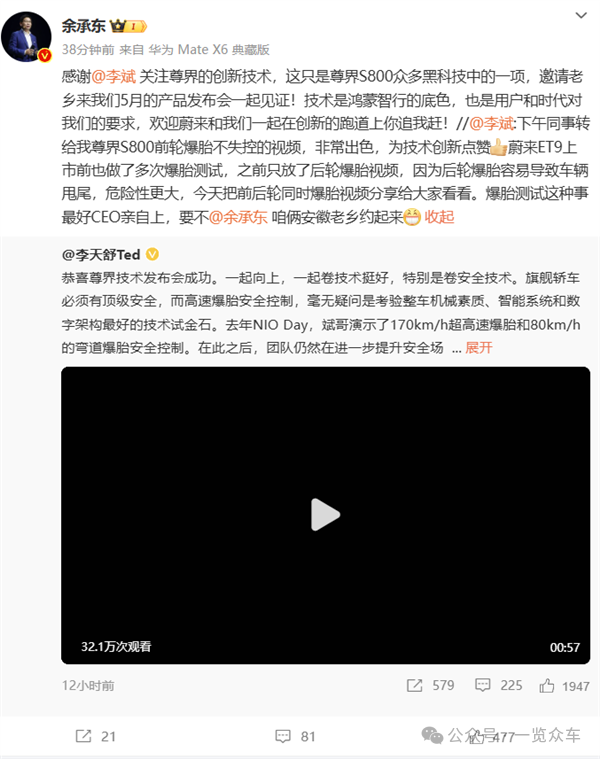
Yu Chengdong did not decline the invitation and extended an invitation to his fellow countryman Li Bin to witness the launch of Zenith S800 in May.
Zenith S800's goal is clear. Yu Chengdong hopes that Zenith S800 can break into a market that NIO has yet to conquer: the premium segment dominated by BMW 7 Series, Audi A8, Maybach S-Class, and Porsche Panamera. To showcase Zenith S800's impressive capabilities, Yu Chengdong specifically conducted a comparative test between Maybach S-Class and Zenith S800.
Li Bin once lamented, "The 78SP market is relatively exclusive, and it is extremely difficult for Chinese brands to penetrate this market." Yu Chengdong disagrees, believing that Zenith S800, backed by cutting-edge technology, is here to break this "exclusivity."
Of course, whether it can succeed remains to be seen.
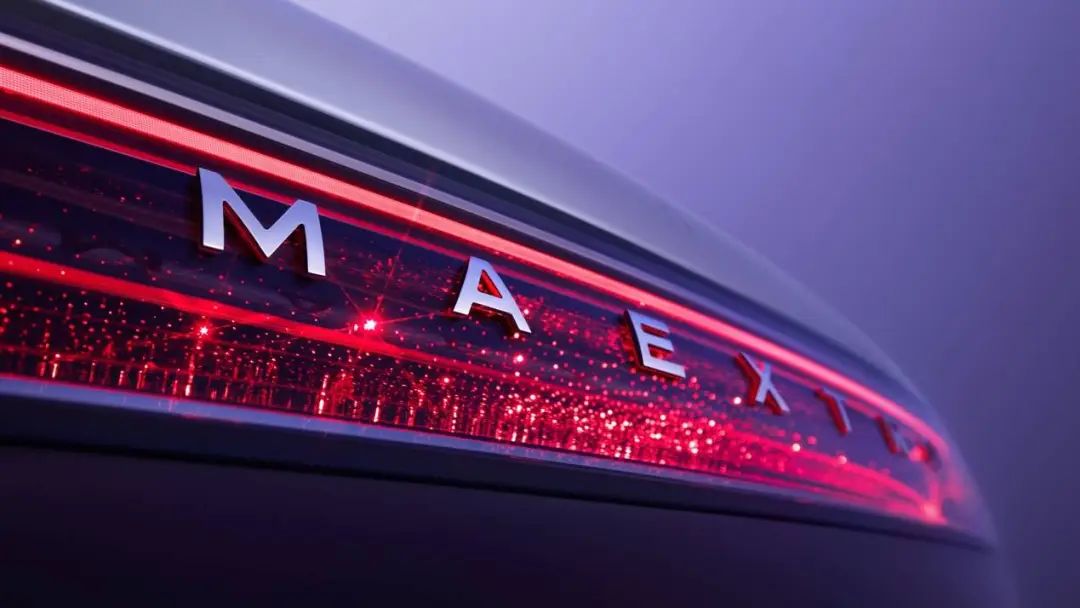
As Yu Chengdong and Li Bin engage in a "technical debate" from afar, they jointly call on the entire industry to "focus on technology and innovation" without mentioning the "intelligent driving war" initiated by BYD.
On February 11, BYD announced the advent of the "era of intelligent driving for all" through a conference, covering advanced intelligent driving in the price range of 70,000 to 200,000 yuan. BYD's logic is to use the scale advantages of the manufacturing end to offset the high cost of intelligent driving and achieve technological equality. "The Chinese auto market is ushering in an intelligent driving storm," industry analysts said.
After BYD's technology conference, Yu Chengdong was the first to speak up, saying, "Intelligent driving that is just barely usable and intelligent driving that is both usable and safe are completely different levels! Just like making a phone call only requires a network, but surfing the internet requires 5G!"
Subsequently, Wei Jianjun, the leader of Great Wall Motors, followed up, saying, "Intelligent driving is not a show; practice reveals true knowledge." He Xiaopeng, the founder of Xpeng Motors, which has always marketed intelligent driving as a selling point, expressed a welcoming attitude. Lei Jun did not express an opinion but announced on the night of BYD's conference that Xiaomi's end-to-end, parking spot-to-car full-scenario intelligent driving would begin to be rolled out successively.
The battle for intelligent driving is about to ignite, and it's getting intense.
The Catfish Arrives
Before BYD's intelligent driving storm fully blows, the catfish, Tesla FSD, has finally landed in the Chinese market.
On February 25, Tesla officially began rolling out software updates for its FSD intelligent driving feature in batches to the Chinese market. After the update, the vehicle can navigate straight, turn left or right, make U-turns, change lanes automatically, etc., on urban roads. Additionally, the in-vehicle cameras will monitor the driver's attention.
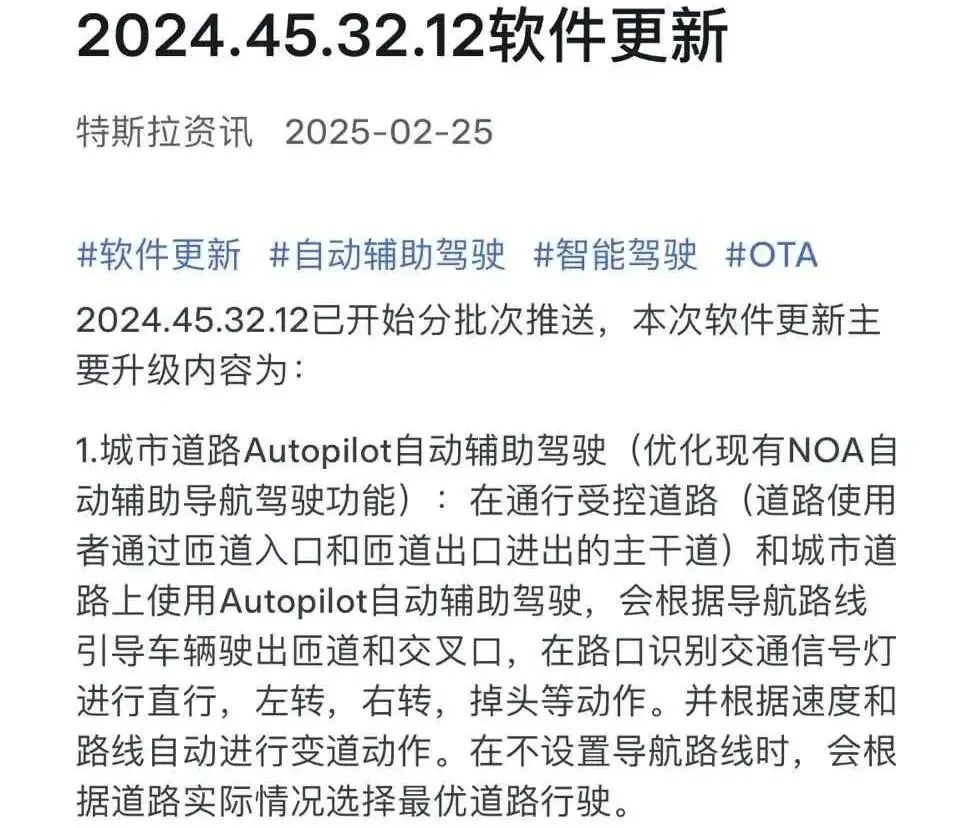
However, due to data compliance issues, the FSD being rolled out this time is not the full-featured FSD with full autonomous driving capabilities available in the US but a "non-complete" version of the FSD intelligent driving feature. Musk mentioned on the social platform X, "We are only using publicly available videos of Chinese roads and signs on the internet and using them to train simulations."
Currently, Tesla's FSD is at the L2 level and requires the driver's full supervision during use. Many car owners have reported issues such as crossing solid lines, running red lights, and mistakenly entering non-motor vehicle lanes, indicating that it is not yet fully adapted to Chinese road conditions. "It doesn't recognize temporary traffic lights, and I've gone through two red lights so far."
Musk once said, "One of the biggest challenges for Tesla's FSD to enter China is the bus lanes, and some restrictions create a complex situation for deploying FSD in the Chinese market."
To address this, in February this year, Tesla dispatched some of its American autonomous driving engineers to China to localize and optimize algorithms for the mature version of FSD. Analysts at Nomura Securities said that the initial attempt to roll out updates provides a testing ground for Tesla to test its advanced driver assistance system in China, but it will still take time to ensure that its FSD is fully adapted to the Chinese market.
Although Tesla's FSD seems to have been "hastily launched" and does not occupy an absolute upper hand in the Chinese intelligent driving market, its learning capabilities cannot be underestimated.
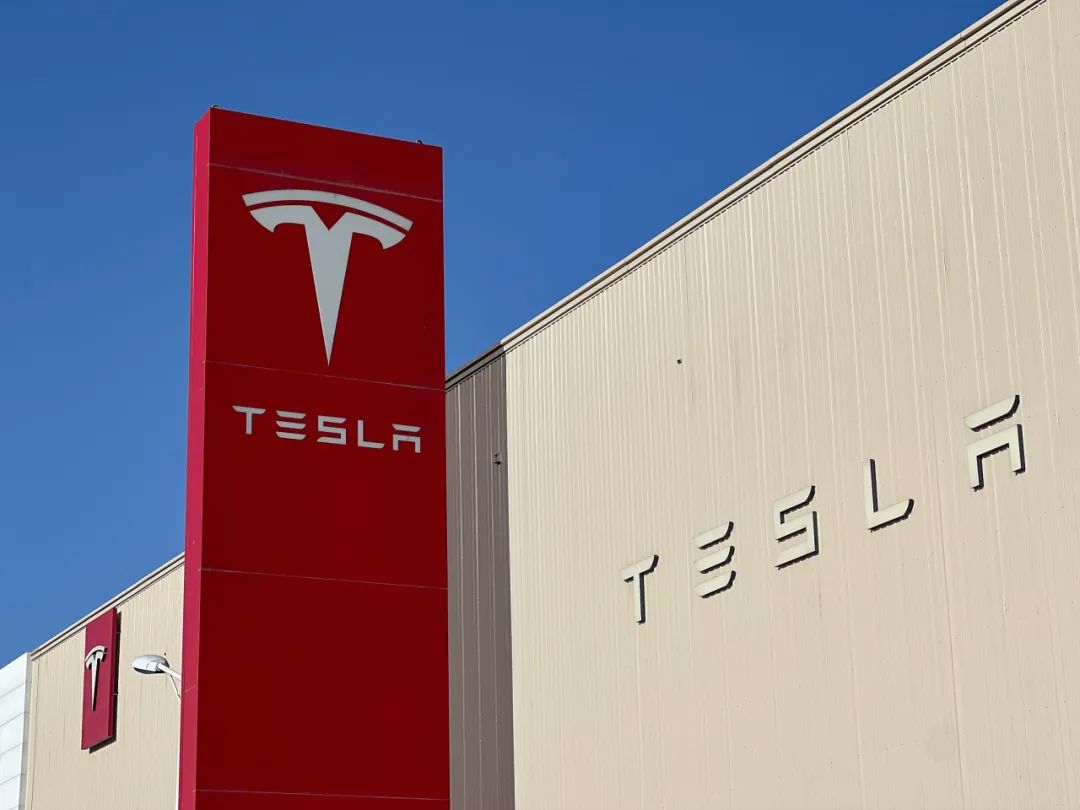
Issues that arose on the first day have now been automatically corrected by the system, and FSD's learning ability will exponentially accelerate its adaptation to Chinese road conditions. Some media outlets have found in real-vehicle tests that on the same road, Tesla's FSD automatically corrects previously wrong routes on the second pass.
Moreover, Tesla has its own "catfish" effect, and on the day FSD was rolled out, it sparked a frenzy of test drives.
On a used car platform, a netizen is renting a Tesla with FSD functionality for 2,888 yuan per day. The product description page reads, "Accepting reviews, OEM testing, live streaming, can issue invoices, seize traffic first." A Tesla owner is renting their vehicle for 400 yuan per day, stating that although their vehicle has not yet been officially rolled out with FSD functionality, prepayment allows them to get in line early so that everyone can experience this new feature together.
Although the industry is calling for "letting the bullets fly for a while," Tesla's catfish effect remains strong. Regarding Tesla's FSD entry into China, many auto industry leaders have expressed a welcoming attitude towards technological competition and mutual progress.

"I'm glad to see Tesla actively promoting the deployment of FSD in China!" said Yu Chengdong. The future of intelligent driving is not only a competition of technologies but also a profound understanding and practice of safety, experience, and user value.
Of course, it's not Yu Chengdong's style to simply express welcome. In addition to welcoming it, Yu Chengdong issued another challenge.
He stated that Huawei's intelligent driving, even without lidar, is better than FSD, and its performance with lidar is even better. "They (Tesla) don't use lidar, but we do, making up for perception capabilities. In China, we have a slight advantage over them."
Li Xiang, the founder of Li Auto, directly issued a challenge, saying, "Welcome to compare Li Auto with Tesla FSD." He also stated that the newly upgraded AD training model based on 10 million Clips would be fully rolled out on February 27.
The scent of battle is strong.
Note: Some images are sourced from the internet. If there is any infringement, please contact us for removal.







